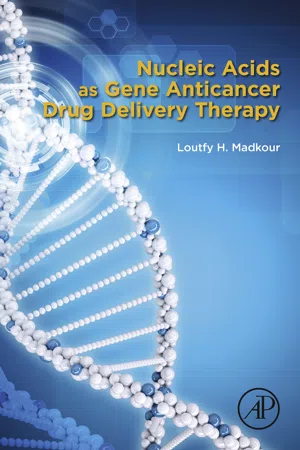
- 650 pages
- English
- ePUB (mobile friendly)
- Available on iOS & Android
Nucleic Acids as Gene Anticancer Drug Delivery Therapy
About This Book
Nucleic Acids as Gene Anticancer Drug Delivery Therapy highlights the most recentdevelopments in cancer treatment using nucleic acids, nanoparticles and polymer nanoparticles for genomic nanocarriers as drug delivery, including promising opportunities for targeted and combination therapy. The development of a wide spectrum of nanoscale technologies is beginning to change the scientific landscape in terms of disease diagnosis, treatment, and prevention.This book presents the use of nanotechnology for medical applications, focusing on its use for anticancer drug delivery. Various intelligent drug delivery systems such as inorganic nanoparticles and polymer-based drug delivery are discussed.The use of smart drug delivery systems seems to be a promising approach for developing intelligent therapeutic systems for cancer immunotherapies and is discussed in detail along with nucleic acid-targeted drug delivery combination therapy for cancer. Nucleic Acids as Gene Anticancer Drug Delivery Therapy will be a useful reference for pharmaceutical scientists, pharmacologiests, and those involved in nanotechnology and cancer research.
- Discusses intelligent drug delivery systems such as inorganic nanoparticles and polymer-based drug delivery
- Contains a comprehensive comparison of various delivery systems, listing their advantages and limitations
- Presents combination therapy as a new hope for enhancing current gene-based treatment efficacy
Frequently asked questions
Information
Advanced drug delivery systems: New nanomedication technologies
Abstract
Keywords
- ● dimensions in the range 1–100 nm
- ● designed using methodologies that exhibit fundamental control over the physical and chemical attributes of molecular-scale structures.
1.1 Nanotechnology of health design
Table of contents
- Cover image
- Title page
- Table of Contents
- Copyright
- Preface
- Summary
- About the Author
- Chapter 1: Advanced drug delivery systems: New nanomedication technologies
- Chapter 2: Characteristics of deoxyribonucleic acid
- Chapter 3: Characteristics of ribonucleic acid
- Chapter 4: Clinical applications of nucleic acid (DNA) gene therapeutics delivery systems
- Chapter 5: Therapeutic applications of siRNA gene delivery systems
- Chapter 6: Targeting mechanisms of polymeric micelles for delivery of siRNA in cancer therapy
- Chapter 7: Classifications of DNA binding molecules—Drug interactions
- Chapter 8: Structures of quadruplex nucleic acids and their drug complexes
- Chapter 9: Solvent-accessible surfaces of proteins and nucleic acids
- Chapter 10: Nucleic acid medicines as green novel anticancer drugs
- Chapter 11: Correlation between nucleic acids and nanoparticle therapeutics for cancer treatment
- Chapter 12: Drug delivery systems as advanced nanotechnology
- Chapter 13: Nanoparticle and polymeric nanoparticle-based targeted drug delivery systems
- Chapter 14: Polymer nanoparticle drug-nucleic acid combinations
- Chapter 15: Combinational delivery therapies of nucleic acids for cancer treatment
- Chapter 16: Multiple delivery of drug-nucleic acid combinations for cancer treatment
- Chapter 17: FDA and the medical device clinical drug trials
- Chapter 18: Biological barriers to cancer drug delivery, efficacy and cancer models
- Chapter 19: Toxicological considerations of clinically applicable nanoparticles
- Chapter 20: DNA complexes as an efficient gene anticancer drug delivery therapy
- Chapter 21: Immunotherapy with mRNA vaccination and immunomodulation nanomedicine for cancer therapy
- List of abbreviations
- Index